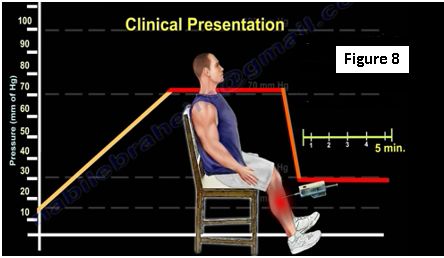CECS is an exercise-induced neuromuscular condition that occurs when a compartment cannot accommodate for the increase in muscle volume and pressure during exercise (Figure 1).

CECS of the lower leg occurs bilaterally in 80-90% of patients. The distribution by compartment is as follows: anterior compartment 40-60%, lateral compartment 12-35%, deep posterior compartment 32-60%, and the superficial posterior compartment 2-20%.
In rare occasions, cases of CECS occur in the thigh, foot, forearm and the hand. Increase blood flow during exercise can cause up to 20% increase in muscle volume. In CECS patients, the osteofascial compartment cannot accommodate the expanding tissue volume, which raises the intra-compartmental pressure. While the elevated pressure may lead to ischemia and pain, it is not enough to cause irreversible damage to the tissues.
The high pressure does cause pain, tenderness, swelling, paresthesia, and weakness that usually affects the activity. Symptoms may be due to relative ischemia, stimulation of the fascia or the periosteal sensory nerves by increased compartment pressures in response to reduced blood flow.
Differential Diagnosis
Medial tibial stress syndrome (shin splints) often develops in distance runners (Figure 2). The pain is diffuse in the distal third of the anterior leg, usually over the medial border of the tibia.

A stress fracture usually develops in those who sharply increase their training activity who perform high impact sports (Figure 3). Most stress fractures are located at the distal third of the tibia, but they may occur anywhere on the tibia or fibula. A runner with pain in the leg may have a stress fracture and the x-ray may be negative. A bone scan or MRI may be needed for the diagnosis.

A deep vein thrombosis is caused by a blood clot, usually from trauma, surgery or prolonged immobilization (Figure 4). It includes diffuse pain, tenderness and swelling throughout the leg. A Doppler may be necessary for the diagnosis.

A nerve entrapment often involves the superficial peroneal nerve, but the deep peroneal or sural nerve can be entrapped (Figure 5). Pain and paresthesia begins with exertion of the distribution of the involved nerve. Tinel’s sign is usually positive.

Vascular disorders may also be a differential diagnosis with popliteal artery entrapment syndrome being the most common (Figure 6). Claudication from atherosclerotic disease and venous insufficiency are possible.

Radiculopathy is radiating pain from the lumbosacral spine to the lower leg even when at rest (Figure 7). The pain is sometimes accompanied with weakness and paresthesia.

With fascial defects, pain may occur over the distal, anterolateral leg where the superficial peroneal nerve exits the lateral compartment. Herniated muscle may be visible and tender to palpation.
In CECS patients, the resting intra-compartmental pressure is usually greater than 15 mm Hg. Pain, swelling, claudication and paresthesia will occur after exercise. The pressure will remain over 30 mm Hg for 1 minutes after the end of the exercise. Pressure remains over 20 mm Hg for longer than 5 minutes after the end of the exercise (Figure 8).

Clinical Presentation
CECS presents itself bilaterally in 80-95% of patients. The anterior compartment is the most frequently involved compartment (70%). The incidence occurs more in males than in females. The physical examination is often normal before exercise. The onset of pain is usually predictable and reproducible at a specific disease and/or intensity. If left untreated, symptoms will worsen or become constant.
Diagnosis/Treatment
The diagnosis is made by intra-compartmental pressure measurement. The patient should be placed in a supine position with the knee in 10-30° of flexion and the foot in 20° plantar flexion. One or more of the following is generally accepted as diagnostic: a pre-exercise pressure greater than 15 mm Hg, a post-exercise pressure at 1 minute that is greater than 30 mm Hg, or a post-exercise pressure at 5 minutes of greater than 20 mm Hg.
Conservative treatments include cessation of causative activity, rest, ice, physical therapy and deep massage. These treatments, however, are generally unsuccessful.
A fasciotomy is the only proven, successful treatment of CECS and is recommended if the symptoms worsen or continue for several months (Figure 9). Following physical therapy, a complete recovery and full return to activity are typical within 8 to 12 weeks. Recurrence can occur up to 20% within two years.

For more information on compartment syndrome, follow the links below:
For more information, visit my YouTube Channel
